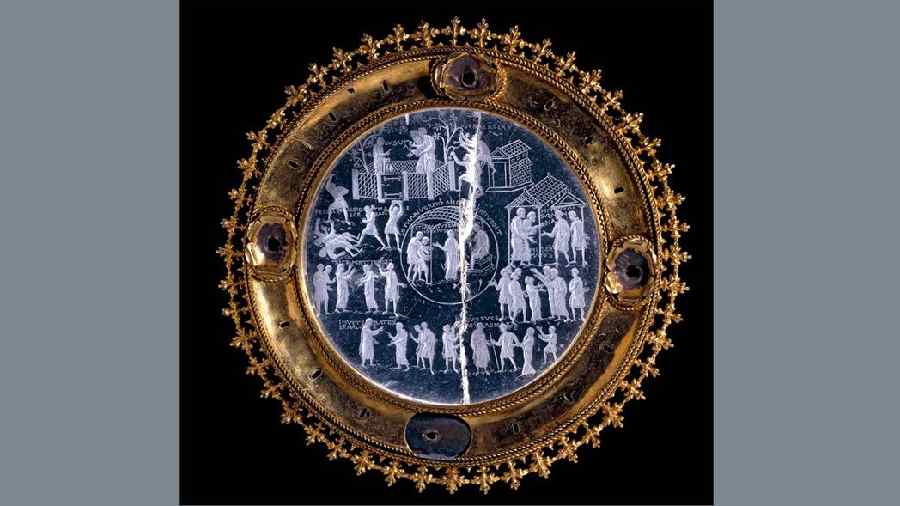Learn from the past — that is an appeal generations of kids have been hearing in history class, and a maxim museums have in mind when they curate exhibitions. The Cologne exhibition "Susanna. Images of a Woman from the Middle Ages to Metoo" shows how well that approach works for art history.
Biblical Susanna
Susanna is the central and sole subject of the show. Her tale is told in the Bible under the title "Susanna in the bath" or "Susanna and the (two) elders."
A pious and beautiful society wife in Babylon in the 6th century BC, Susanna is stalked by two lecherous old judges. They assault her as she undresses for a bath. She defends herself, vehemently and successfully, but the men then accuse her of having committed adultery. She is arrested, and found guilty in a trial. A young boy by the name of Daniel appears and convinces the crowd of the true story. The two old men are sentenced to death, and Susanna is returned to her family.
There are in fact two different Susanna narratives. The Septuagint version was probably written in the 1st century B.C. and has a different emphasis in terms of content. The Susanna tale that is most widely told is the version found in the Old Testament — a version referred to countless times in legal history and in the arts.
90 times a victim, 90 times an offender
The Cologne exhibition is the first to showcase all of 90 Susannas. The Susanna story was after all not a marginal phenomenon: she shows up in everyday objects like carved wooden cabinets as well as in magnificent paintings by Rembrandt and Rubens.
Could it be that sexualized abuse has always been a theme? Curators Anja Sevcik and Roland Krischel explore this question by relating the many versions of Susanna in a new way and confronting them with modern questions. Visitors see Susanna in various roles, from helpless victim to woman who defends herself, and are presented with offenders whose assaults are more or less violent, who turn demonic, antisemitic and racist. The various versions are clear and understandable, including their moral and/or erotic charge.
The many different roles and themes make Susanna such an interesting subject, the curators argue, from righteous rule and strong faith to marital chastity, social morality, beauty and voyeurism. They do not think "sex sells" was the main motive for patrons and artists, but that they were after emotionally stimulating images which in turn made the Susanna motif so popular.
All the same, they agree that the male gaze, which is a way of looking at women that sexualizes them, is definitely noticeable. Since the 15th century, Susanna has mostly been painted or drawn naked, often in extravagant poses. On the other hand, it is a young 17th century painter named Anthonis van Dyck who most strongly denounces the presumptuous male attitude, according to Krischel.
Role reversal
It becomes clear that a reversal sets in where Susanna is portrayed in a more eroticized fashion. The alluring woman comes across as co-actor, which reverses the roles — in court proceedings or public debates even today, women are often suspected of complicity in sexual violence, for instance if they wear anything remotely sexy. Depending on the case, the absence of a scarf may be enough. The consequences range from acquittal for offenders, to shaming women and even to the death sentence.
Artemisia Gentileschi — a feminist icon
Artemisia Gentileschi's Susanna is a highlight in the exhibition. The Italian Baroque painter (1593-1654) was a highly decorated, busy painter, which was unusual for her time. Gentileschi worked in large formats and executed many history paintings — usually reserved for male painters — as well as mythological and biblical subjects.
The long-forgotten painter was rediscovered by feminists in the 1960s and '70s — Gentileschi often painted pictures with female heroines, including Judith, Lucretia, Cleopatra, Mary Magdalene and Susanna. The women are portrayed as courageous, determined and energetic. Today, Gentileschi is considered a proto-feminist, anticipating modern feminism when the concept did not yet exist.
Contemporary Susanna motif
The exhibition also shines a light on contemporary art, including the Susanna motif in Hitchcock's 1960 thriller "Psycho" and photographic positions, for instance by the American artist Zoe Leonard.
It makes sense to approach the issue of sexualized violence via art history, as representation is a problem and explicit depictions could be re-traumatizing or simply degrading. The fact that there is still a great need to talk about boundaries, alleged consent and victim blaming even today became overly clear in the wake of the #MeToo movement. The museum offers guided tours for school classes with protected spaces for debate. It is a promising, artistic model to help people overcome inhibitions and open up about the topic of sexual violence.
The "Susanna" exhibtion is on at the Wallraff-Richartz Museum in Cologne from October 28 to February 26, 2023.











